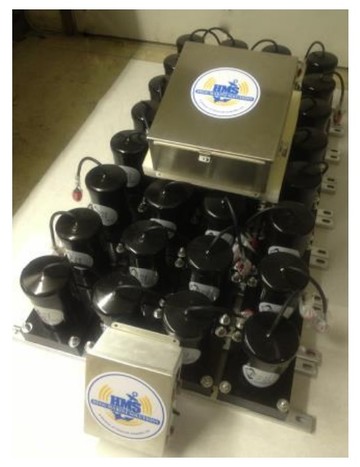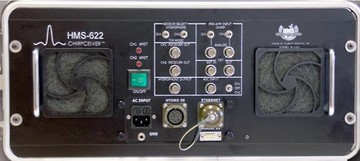HMS-622 CHIRPciever
from Falmouth Scientific
The Chirpceiver is a transducer array which allows the user to use a wide range of frequency bands, from low frequency (1KHz-10KHz) to High frequency (8KHz-23KHz) to support sub-bottom profiling projects. Conversely, an optional Ultra-Low frequency band (200Hz-2KHz) can also be supplied if required. In addition to this the HMS-622 can be configured to up to 50KHz with the 2 Channel transceiver along with the CW frequencies, this will depend on the band as the transducers and hydrophone arrays are configured to transmit and receive.
The CHIRP or CW operation modes such as Start/Stop frequencies, Pulse lengths and Power levels for the output can be easily set using the Graphical User interface, via ethernet cable. This allows gain attenuation and diagnostic modes to be measured.
The receiver supports multiple ping modes for higher track resolution when working in deeper abyssal levels at a greater ping rate, and allows direct A/D input from the HMS-620 Bubble Gun along with other analogue marine seismic systems. All data is then logged in SEGY format with the industry standard acquisition software.


Features
- Acoustic Pulses allow for greater depth penetration through an array of sediment types
- Data control via Ethernet Cable
- 85 to 240VAC universal input power supply
- Dual-channel 24-bit, direct A/D Range for Analog Seismic Systems like the FSI Bubble Gun
- 4KW ch Output Power
- Flexible transducer array (for vessel configuration and survey needs)
- LF (1KHz-10KHz) (Standard), HF (8KHz-23KHz), ULF (200Hz-2KHz) (Optional)
Technical Specifications
| LF Transmitter and Transducer: | 1 to 4, 3.5KHz transducers (Towed/ Over the side systems); 4 to 35 (Hull Mounted Systems) |
|---|---|
| Output Power: | 2.3KW, 15% Duty Cycle at 3.5 KHz for 1µPa at 1 m nominal maximum 4 KW |
| Frequency Range: | 1KHz to 10KHz band |
| Transducer Radiation: | 45° Conical (2x2 4- element array) |
| ULF Transmitter and Transducer: | AT-650 Transducer |
| Output Power: | 2.3 KW, 15% duty cycle at 650Hz for 204 dB re 1 µPa @ 1 m nominal, 4 KW maximum |
| Frequency Range: | 200HZ to 2KHz band |
| Transducer Radiation: | Omni |
| HF Transmitter and Transducer: | 7 element High Frequency transducer |
| Output Power: | 1 KW, 15% duty cycle at 15 KHz for 214 dB re 1 µPa @ 1 m nominal, 4 KW maximum |
| Frequency Range: | 8KHz to 2KHz band |
| Transducer Radiation: | 27° Conical |
| Software Trigger: | Internal or External |
| Pulse Length: | 5-100ms CHIRP and CW modes (15% duty cycle) |
| Transmitting Power: | 0 to -21dB in 3 dB minimum increments |
| Preamplifier gain and attenuation: | 42dB in 3dB increments (gain); -42dB in 3dB increments |
| A/D Input: | 24-bit to 192KHz |
